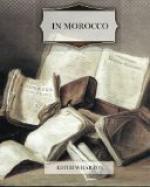The Caid is a great man. He and his famous elder brother, holding the southern marches of Morocco against alien enemies and internal rebellion, played a preponderant part in the defence of the French colonies in North Africa during the long struggle of the war. Enlightened, cultivated, a friend of the arts, a scholar and diplomatist, he seems, unlike many Orientals, to have selected the best in assimilating European influences. Yet when I looked at the tiny creature watching him with those anxious joyless eyes I felt once more the abyss that slavery and the seraglio put between the most Europeanized Mahometan and the western conception of life. The Caid’s little black slaves are well-known in Morocco, and behind the sad child leaning in the archway stood all the shadowy evils of the social system that hangs like a millstone about the neck of Islam.
Presently a handsome tattered negress came across the garden to invite me to the harem. Captain de S. and his wife, who had accompanied me, were old friends of the Chief’s, and it was owing to this that the jealously-guarded doors of the women’s quarters were opened to Mme. de S. and myself. We followed the negress to a marble-paved court where pigeons fluttered and strutted about the central fountain. From under a trellised arcade hung with linen curtains several ladies came forward. They greeted my companion with exclamations of delight; then they led us into the usual commonplace room with divans and whitewashed walls. Even in the most sumptuous Moroccan palaces little care seems to be expended on the fittings of the women’s quarters: unless, indeed, the room in which visitors are received corresponds with a boarding-school “parlour,” and the personal touch is reserved for the private apartments.
The ladies who greeted us were more richly dressed than any I had seen except the Sultan’s favourites, but their faces were more distinguished, more European in outline, than those of the round-cheeked beauties of Rabat. My companions had told me that the Caid’s harem was recruited from Georgia, and that the ladies receiving us had been brought up in the relative freedom of life in Constantinople; and it was easy to read in their wistfully smiling eyes memories of a life unknown to the passive daughters of Morocco.
They appeared to make no secret of their regrets, for presently one of them, with a smile, called my attention to some faded photographs hanging over the divan. They represented groups of plump provincial-looking young women in dowdy European ball-dresses; and it required an effort of the imagination to believe that the lovely creatures in velvet caftans, with delicately tattooed temples under complicated head-dresses, and hennaed feet crossed on muslin cushions, were the same as the beaming frumps in the photographs. But to the sumptuously-clad exiles these faded photographs and ugly dresses represented freedom, happiness, and all they had forfeited when fate (probably in the shape of an opulent Hebrew couple “travelling with their daughters”) carried them from the Bosphorus to the Atlas.




